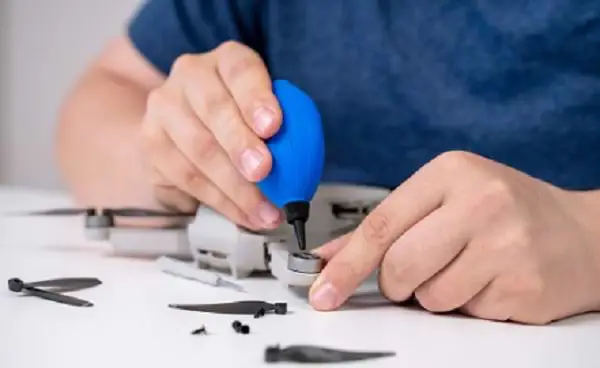
If you know anything about hobby drones, you’ll know that most of them don’t come cheap! With that being said, you probably don’t want them to break—which begs the question of how easily do they break? I did some research and here’s what I found.
Hobby drones don’t always break easily during a crash. Lightweight, cheap hobby drones are prone to crashing and generally sustain a lot of damage during a crash. On the other hand, heavier, more expensive hobby drones tend to be less prone to crashing because of smart flying features, and since they are designed better, they tend to sustain less damage.
Keep reading to find out how to avoid breaking your drone and what factors influence the level of damage a drone may succumb to.
Drone Quality VS. Durability
Drones are the new “it” thing at the moment, which is why many people are looking into trying out the hobby. But many are skeptical about drones being highly breakable and expensive.
Just like any piece of machinery or technology, hobby drones are also ranging in price. Drones can cost anywhere from $20-$10,000, and the price tag can also have an effect on how durable it is when it comes to an accident because of two reasons.
- Smart flying features help avoid crashes in the first place. This is something your cheaper drones aren’t equipped with.
- Generally, the more expensive a drone is, the more durable it is. The manufacturer would have put a lot more effort into designing a durable body to minimize damage during a crash.
Cheap hobby drones that are more difficult to fly, and break easily.
When a drone is cheap, usually under $200, they tend to be easier to break because well, you generally get what you paid for.
On top of that, cheap drones are a lot easier to crash because of the lack of smart flight technology installed in them. They don’t have any sensors that will take over flight control if you get too close to an during flight for example. In most cases, the crash of a cheap drone is less to do with the pilot, and more to do with the software and technology—or lack thereof.
Here are some example of cheaper drones:
| Drone: | Obstacle Avoidance Detection? | Price: | Purchase Link: |
| Hubsan X4 | NO | $25 | VIEW |
| Supkiir Drone | NO | $52 | VIEW |
| ScharkSpark SS41 Beetle | NO | $69 | VIEW |
| JJRC H6D FPV | NO | $90 | VIEW |
Expensive hobby drones that are easier to fly, and don’t break as easily.
The heavier, more expensive hobby drones that generally cost over $400 are way easier to fly because they are usually fitted with sensors that give a drone the ability to almost fly itself and take over during flight when it senses danger, which is also known as obstacle avoidance.
On top of that, because drones are so prone to crashing, drone manufacturers such as DJI have invested millions into designing their drones to be as durable as possible. Which is one of the reasons why these drones come at a hefty price.
Here are some example of higher quality expensive drones:
| Drone: | Obstacle Avoidance Detection? | Price: | Purchase Link: |
| DJI Mavic Air 2 | YES | $799 | VIEW |
| Mavic 2 Pro | YES | $1,599 | VIEW |
| Skydio 2 | YES | $999 | VIEW |
| Yuneec Typhoon H / H Plus | YES | $1,899 | VIEW |
How to Avoid Crashing Your Hobby Drone
Despite what you may think, flying a hobby drone is easier than a lot of people make it out to be! However, in order to make the most of your drone and avoid damage, you will need to know more than just the basics.
I am pretty sure we have all seen our fair share of “drone fail videos” on YouTube, and many of them result in awful crashes that can be very expensive for the pilot!
Truth is, most of the crashes in the videos you see on YouTube could have easily been avoided if the pilot had followed simple safety precautions.
With that being said, here are a few easy steps to follow to make sure that you do not crash your drone if you are new to flying or if you have been flying for a while:
Simulation. Before you take your drone on a flight, you should practice in a flight simulator if the drone does has an app that supports this feature. For example, the DJI GO simulator is great for beginners.
This is a great starting point for new flyers as it helps you get used to the drone controls, and pay close attention to which direction the drone is facing.
For instance, if the nose of the drone is facing towards you, then the drone will move right. This works similar to a mirror and may take some time to fully get used to. This is why I also recommend you fly with the nose facing away from you because this can get very confusing.
Manual. I cannot stress this enough—read the user manual! If you can I suggest that you even read it twice. This will help you have a better understanding of your drone.
Practice Returning Home. Some drones don’t have this function, but if your drone does have the function you should definitely practice using it. You also need to understand that you will need a GPS signal before you take off for the function to actually work.
Obstacles. When flying you need to watch out for various obstacles that might be in your way while flying. Things like power lines, wires and tree branches are a large cause of many crashes.
A lot of the higher quality drones like the ones made by DJI and Yuneec, have an obstacle avoidance system that helps pilots most of the time. The only issue is that the obstacle avoidance system cannot detect thin objects like power lines, so you will need to avoid them yourself.
During your first couple of flights, it’s also a good idea to be accompanied by a friend who can keep an eye out for obstacles for you until you can get the hang of flying the drone.
Pre-check drone. Another way that a drone may crash is that there might have been a part of the drone that was not secured properly or slightly damaged from a previous flight. When you do finally take the drone out, this part could come off or break further and cause you to crash, thus causing further damage to your drone.
This just shows how important it is to do a pre-check of your drone before you take off. If you pre-check the drone you will notice the broken or loose part and be able to change it before you actually fly the drone.
Flips and tricks. I fully recommend learning to do a few tricks with your drone once you are skilled enough to pull them off. Although do bare in mind that excessive flips and tricks could cause you to lose control of your drone or cause your propellers to slowly become loose which will end up causing you to crash.
Low flying. This is one of the most common mistakes drone pilots make. Flying too close to the ground might seem appealing and safer because you think that you are reducing the risk of a big crash, especially if you are still new to flying.
This is actually the opposite—you should avoid flying too low to the ground if you are still new to flying, as it is much harder to control the drone when it is flying closer to the ground.
When the drone propellers spin, they push air downwards in order to create thrust to push the drone off the ground and take it higher and higher.
When you fly too close to the ground, the air that is pushed down is bounced off the ground and back at the drone which will make it a lot harder to fly because it will be unstable, and this can cause you to lose control and even flip the drone!
Too much throttle. If you are new to any sort of hobby or sport, going too fast too soon is never a good idea.
When you are new to flying it is best that you keep a medium speed at most to ensure that you always in full control of the drone. Of course, when you are more experienced you can go faster, but it is never a good idea to have too much throttle.
Flying Area. You should always do a pre-flight check of the area that you will be flying in before you fly there.
You should also always obey FAA rules and regulations and comply with their No-Fly Zones which will require you to check beforehand. You should also avoid areas with strong interference (like near large metal objects) and do not take off under high-voltage power lines.
Weather. When you are checking the area in which you are going to be flying your drone, it is also important that you check the weather in the area as well.
You should avoid flying when it is very windy. Any small drone is unstable in the wind, which is most likely the kind of drone you will be flying if you are a beginner. So, be careful!
